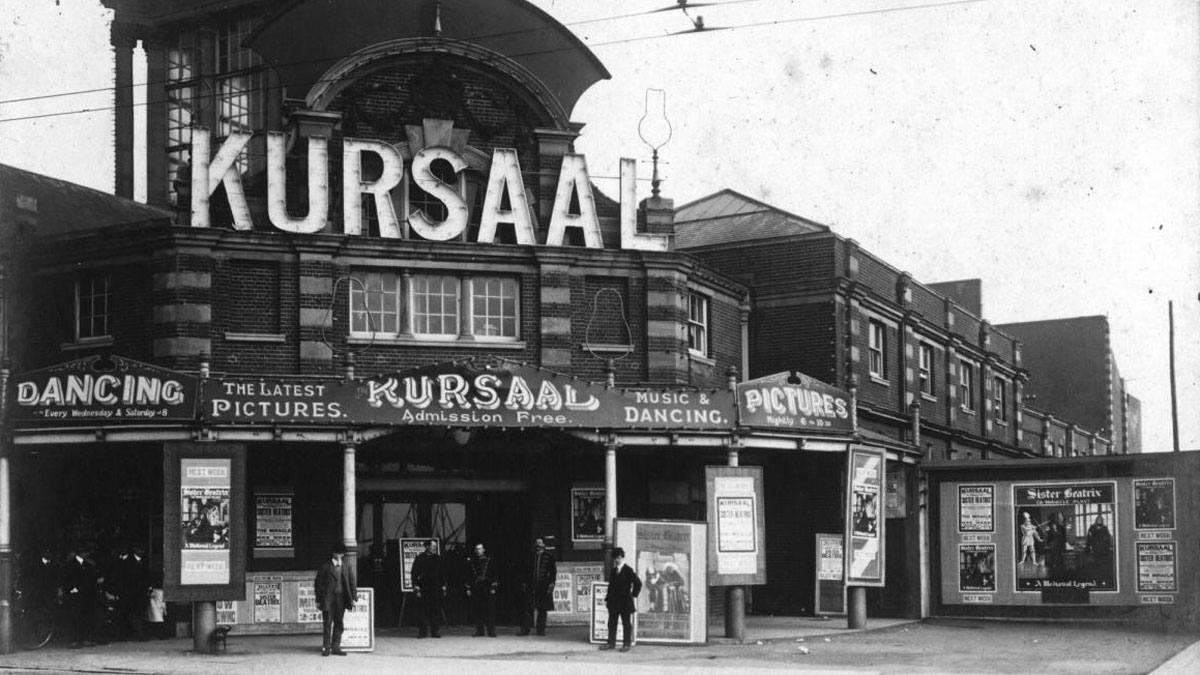|
The Kursaal - home to the world’s first purpose-built amusement park - has been named in the Victorian Society’s annual list of endangered buildings in England and Wales

Tom Anstey | Planet Attractions | 03 Jun 2024

 Kursaal Palace opened in 1901 as an amusement park Kursaal Palace opened in 1901 as an amusement park
The Victorian Society has revealed its annual list of endangered buildings in England and Wales, with one of the world’s first purpose-built amusement parks included in this year’s selection.
The charity, which campaigns to preserve Victorian and Edwardian architecture, compiles its list to raise awareness of real buildings at risk of being lost.
Among those listed for 2024 is the Kursaal in Southend, Essex. Opened in 1901 as Kursaal Palace, the venue featured a circus, ballroom, arcade, dining hall, billiard room, zoo and an ice rink. In 1910, under new management it opened a large list of attractions, including the Harton Scenic Railway and Figure of Eight roller coaster, The park was claiming more than 100,000 visitors a week before a fire in 1911 that destroyed two major attractions. Between 1919-1934 it was also home to Southend United Football Club.
Undergoing several ownerships and management changes through the decades, the majority of the park was closed in 1973, with the rest of the site closing in 1986. Today most of the building remains empty except for a small Tesco Express supermarket.
British comedian and actor, Griff Rhys Jones, who is president of the charity, said the list, which also includes one of the world’s first tennis pavilions and a famous glassworks, was “terrifying”.
“How terrifying to see buildings I have known, loved or used all my life in Southend and Cardiff in need of rescue,” he said.
“Look at the character on display here. They all add colour and story to any urban landscape. Their restoration and reuse make huge commercial sense. They are attractions in themselves. They are already destinations. They should be part of local pride.
“These are ready-made fascinators, waiting for new uses. Too many end up in the hands of owners who hope that deliberate neglect will allow them to demolish them.
“Be imaginative. Join us to show your support for prompt re-use. Join us at the Victorian Society in urging on these national treasures. And many others like them.”
The full list includes:
• Kennington Boys’ School (Cormont Road School), Lambeth. Grade II, Architect: T J Bailey, 1898
• The Kursaal, Southend-on-Sea, Essex. Grade II, Architect: George Sherrin, 1898-99
• Jesmond Dene Banqueting Hall, Newcastle Upon Tyne. Grade II, John Dobson, extended to provide a gatehouse, reception hall and display room, Norman Shaw, 1860-62 and 1869/70
• The former Bramcote Tennis Pavilion, Scarborough, N. Yorkshire. Grade II Architect: John Hall, 1885
• St Luke’s Chapel, Nottingham City Hospital, Nottinghamshire. Grade II, Architect: Arthur Marshall, 1902
• St Martins (formerly Roslyn Hoe), Ilfracombe, Devon. Grade II Architect: WM Robbins of Ilfracombe,1880
• Chances Glassworks, Smethwick, Sandwell. Scheduled Monument, comprising nine Grade II structures, Architect: Unknown, 1847 - 60
• St Agnes’ Vicarage and Hall, Liverpool, Merseyside. Vicarage Grade II* and Hall Grade II. Architect: Norman Shaw, 1887
• Former Education Dept Offices, Derby, Derbyshire. Grade II, Architect: Giles & Brookhouse, 1871
• Cardiff Coal Exchange, Butetown, Glamorgan. Grade II*. Architect: Seward & Thomas, 1884-86
“As in previous years, the 2024 list is one that showcases the extraordinary diversity, interest and quality of Victorian and Edwardian architecture across England and Wales,” said James Hughes, Victorian Society director.
“However, it is one that again highlights the ongoing threat that many face, even buildings of genuinely national importance. Two buildings here have appeared in previous editions of this list, highlighting both their chronic difficulties and their ever more acute need for intervention; and the fact that three of the ten buildings are owned by local authorities is arguably a manifestation of increasingly restrictive Council budgets. But irrespective of their precise circumstances - and those of their owners - all these buildings are united in being important and endangered, and it is imperative that means are found to ensure their short-term survival and to secure their long-term and appropriate reuse.”
Heritage
|
|






Supplier Showcase 2025: The biggest attractions projects landing worldwide this year
|